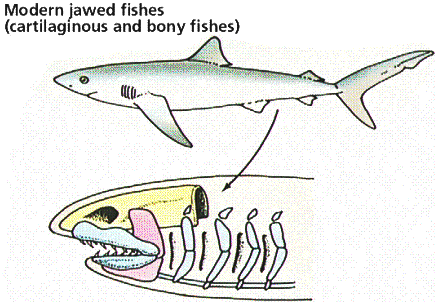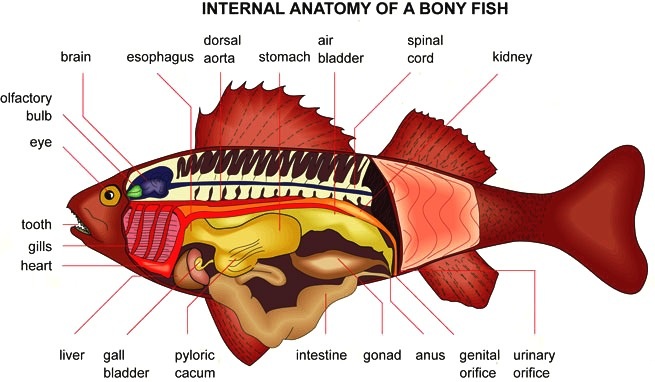Phylum Chordata
Superclass Pisces
Class 1 - Chondrichthyes (Cartilaginous Fishes)
General characters:-
 (1) Mostly marine and predaceous.
(1) Mostly marine and predaceous.
(2) Body fusiform or spindle shaped.
(3) Fins both median and paired, all supported by fin rays.
(4) Skin tough containing minute placoid scales and mucous glands.
(5) Endoskeleton entirely cartilaginous, without true bones
(6) Notochord persistent.
(7) Respiration by 5 to 7 pairs of gills.
(8) Heart 2–chambered (1 auricle and 1 ventricle).
(9) Kidneys opisthonephric. Excretion is ureotelic.
(10) Brain with large olfactory lobes and cerebellum. Cranial nerves 10 pairs.
Class 2 - Osteichthyes (Bony fishes)
General Characters:-
(1) Inhabit all sorts of water-fresh, brackish or salt; warm or cold.
(2) Body spindle-shaped and streamlined.
(3) Fins both median and paired, supported by fin rays of cartilage or bone.
(4) Skin with many mucous glands, usually with embedded dermal scales of 3 types; ganoid, cycloid or ctenoid.
(5) Endoskeleton chiefly of bone.

(6) Respiration by 4 pairs of gills on body gill arches
(7) Ventral heart 2-chambered (1 auricle + 1 ventricle).
(8) Adult kidneys mesonephric. Excretion is ureotelic.
(9) Brain with very small olfactory lobes, small cerebrum and well developed optic lobes and cerebellum.
(10) Well developed lateral line system.
Class Amphibia
General characters:-
(1) Aquatic or semi aquatic (freshwater), air and water breathing, carnivorous, cold–blooded, oviparous, tetrapod vertebrates.
(2) Head distinct, trunk elongated. Neck and tail may be present or absent.
(3) Pigment cells (chromatophores) present.
(4) Exoskeleton absent.
(5) Endoskeleton mostly bony. Notochord does not persist. Skull with 2 occipital condyles.
(6) Respiration by lungs, skin and mouth lining.
(7) Heart 3–chambered (2 auricles + 1 ventricle).
(8) Kidneys mesonephric. Excretion is ureotelic.
(9) Brain poorly developed. Cranial nerves 10 pairs.
(10) Nostrils connected to buccal cavity.
Class Reptilia
General characters:-
(1) Predominantly terrestrial, creeping or burrowing.
(2) Body bilaterally symmetrical and divisible into 4 regions-head, neck, trunk and tail.
(3) Limbs 2 pairs, pentadactyle.
(4) Exoskeleton of horny epidermal scales, shields, plates and scutes.
(5) Skin dry, cornified and devoid of glands.
(6) Alimentary canal terminates into a cloacal aperture.
(7) Endoskeleton bony. Skull is with one occipital condyle (monocondylar).
(8) Heart usually 3–chambered, 4–chambered in crocodiles.
(9) Respiration by lungs throughout life.
(10) Kidney metanephric. Excretion is uricotelic.
Class Aves
General characters:-
(1) Feather-clad, air-breathing, warm-blooded, oviparous, bipedal flying vertebrates.
(2) Limbs are two pairs.
(3) Exoskeleton is epidermal and horny.
(4) Skin is dry and devoid of glands except the oil or preen gland at the root of tail.
(5) Pectoral muscles of flight are well developed.
(6) Skull smooth and monocondylic, bearing a single occipital condyle. Cranium large and dome-like. Sutures indistinct.
(7) Vertebral column short. Centra of vertebrae heterocoelous (saddle-shaped).

(8) Sternum large, usually with a vertical, mid ventral keel for attachment of large flight muscles.
(9) Ribs double-headed (bicephalous) and bear posteriorly directed uncinate processes.
(10) Both clavicles and single inter clavicle fused to form a V–shaped bone, called furcula wishbone.
(11) Heart completely 4–chambered. There are neither sinus venosus or truncus arteriosus. Only right aortic (systemic) arch persists adult. Renal portal system vestigial. Blood corpuscles nucleated.
(12) Birds are the first vertebrates to have was blood. Body temperature is regular (homoiothermous).
(13) Respiration by compact, spongy, distensible lungs continuous with thin air-sacs.
(14) Larynx without vocal cords. A sound box or syrinx, producing voice, lies at or near the junction of trachea and bronchi.
(15) Kidneys metanephric and 3–lobed.
Class Mammalia
General characters:-
(1) Hair-clad, mostly terrestrial, air-breathing, warm blooded, viviparous, tetrapod vertebrates.
(2) Limbs 2 pairs, pentadactyle, each with 5 or fewer digits. Hind limbs absent in cetaceans and sirenians.
(3) Exoskeleton includes lifeless, horny, epidermal hairs, spines, scales, claws, nails, hoofs, horns, bony dermal plates, etc.
(4) Skin richly glandular containing sweat, sebaceous (oil) and sometimes scent glands in both the sexes. Females also have mammary glands with teats producing milk for suckling the young.
(5) Endoskeleton thoroughly ossified. Skull dicondylic having 2 occipital condyles. Cranium large. A single zygonmatic arch present. Pterygoids msall, scale-like. Otic bones fused into periotic which forms tympanic bulla with tympanic. Each half of lower jaw made of a single bone, the dentary, articulating with squamosal of skull Vertebrae with terminal epiphyses and flat centra (acoelous). Cervical vertebrae usually 7. Ribs bicephalous. Coracoid vestigial.
(6) Teeth are of several types (heterodont), borne is sockets (thecodont) and represented by two sets (diphyodont).
(7) Respiration always by lungs (pulmonary). Glottis protected by a fleshy and cartilaginous epiglottis. Larynx contains vocal cords.
(8) Heart 4-chambered with double circulation.

(9) Kidneys metanephric.
(10) Brain highly evolved. Both cerebrum and cerebellum large and convoluted. Optic lobes small and 4 in number called corpora quadrigemina. Corpus callosum present connecting both cerebral hemispheres. Cranial nerves 12 pairs.
(11) Senses well developed. Eyes protected by lids, the upper of which is movable. External ear opening protected by a large fleshy and cartilaginous flap called pinna. Middle ear cavity with 3 ear ossicles–malleus, incus and stapes. Cochlea of internal ear spirally coiled.
(12) Sexes separate.
(13) Fertilization internal preceded by copulation.
(14) Except egg-lying monotremes, mammals are viviparous, giving birth to living young ones.
(15) Development uterine.
Classification of Mammal
(a) Subclass I prototheria : (Gr., protos, first + therios, beast). Primitive, reptile-like, oviparous or egg-lying mammals.
Order 1. Monotremata : (Gr., monos, single + trema, opening), Cloacal opening present Confined to Australian region.
Examples : Monotremes. Platypus or duckbill (ornith orhynchus) spiny anteater (Tachyglossus = Echidna)
(b) Sub class II. Theria : (Gr., ther, Theria are subdivided into 2 living infraclasses)
Infraclass 1. Metatheria : (Gr., meta, between or after).
Pouched and viviparous mammals without or with a rudimentary yolk sac placenta. Confined mostly to Australian region.
Order 2. Marsupialia : (Gr., marsypion, pouch).
Born in a very immature state, and complete their development attached to teats or nipples in the abdominal pouch or marsupium. Usually 3 premolars and 4 molars in each jaw on either side. Vagina double
Examples : Marsupials. Opossum (Didelphis). Kangaroo (macropus), koala (phascolarctos). Kangaroo in the native of Australia
Infraclass 2. Eutheria : (Gr., eu, true + therios + beast)
Higher viviparous placental mammals without marsupium. Young born in a relatively advanced stage. Dentition never exceeds Eutherians constitute the vast majority of living mammals arranged in 16 orders.
 Order 3. Insectivora : (L., insectum, insect + vorare, to eat)
Order 3. Insectivora : (L., insectum, insect + vorare, to eat)
Small mammals with long pointed snout. Feet plantigrade, usually 5–toed, with claws. Molars with pointed, peg-like cusps for insect feeding.
Examples : Mole (Talpa), common shrew (Sorex), Solenodon (Solenodon), hedgehogs (Erinaceus, Paraechinus)
Order 4. Chiroptera : (Gr., Cheiros, hand + pteron, wing)
Flying mammals or bats in which forelimbs are modified into wings. Hind legs short and included in wing membrane
Order 5. Dermoptera : (Gr., derm, skin + pteron, wing). Nocturnal in trees. A gliding mammal called flying lemur, resembling a flying squirrel
Examples : One living genus Cynocephalos (= Galaeoithecus) with 2 species from South eastern Asia.
Order 6. Edentata : (L., edentatus, toothless) Teeth absent or reduced to molars. Without enamel
Examples : Giant antcater (Mryrmecopha) armadillo (Dasypus),
Order 7. Pholidota : (Gr., pholis, a scale) Body covered with large overlapping scales with sparse hair in between. No teeth. Long and protrusible, used to capture insects.
Examples : Single genus of scaly anteaters pangolins (Manis)
Order 8. Tubulidentata : (L., tubulus tube like + dens, tooth)
Examples : Single genus of pig-like aardvark or Cape anteater (Orycteropus) of South Africa
Order 9. Primates : (L., primus, of the first rank)
Generalized or primitive mammals except for the great development of brain. Mostly arboreal. Anthropoidea. The suborder Anthropoidea is further subdivided into two divisions or infraorders, Platyrrhina and Catarrhina.
Order 10. Rodentia : (L., rodo, gnaw)
Largest order including usually small gnawing mammals. Each jaw with one pair of long, rootless, chisel-like incisors growing throughout life. No canines.
Examples : Rat (Rattus), Mouse (Mus) squirrel (Funambulus)
Order 11. Lagomorpha : (Gr., logos, hare + morphe, form)
With a second pair of small upper incisors behind first pair of large chisel like incisors. No canines.
Examples : Rabbit (Oryctolagus), hare (Lepus), Pika (Ochotona)
Order 12. Cetacea : (Gr. ketos or L., cetus, a whale)
Large marine fish-like mammals well adapted for aquatic life pectoral limbs modified into broad paddle-like flippers. Tail divided in two broad horizontal fleshy flukes with a notch, used in propulsion. No claws, no hind limbs and no external ears. The living Cetacea are divided into two suborders Odontoceti (toothed whales) and Mysticeti or Mystacoceti (whalebone whales).
Order 13. Sirenia: (Gr., siren, sea nymph). Large, clumsy herbivorous, aquatic mammals with paddle-like forelimbs, no hindlimbs and a flattened tail with horizontal lateral fleshy flukes with or without a notch. No external ears.
Muzzle blunt. Hairs few. Stomach complex. Inhabit estuaries and coastal sea.
Examples: Manatee (Trichechus), dugong (Dugong = Halicore), recently extinct Steller's sea-cow (Rhytina)
Order 14. Carnivore: (L., caro, tlesh + vorare, to eat) Small to large predatory, flesh-eating mammals.
Examples: Dog (Canis familiaris), Wolf (C. lupus), Jackal (C. aureus), Walrus (Odobenus), common seal (Phoca)
Order 15. Hyracoidean : (Gr., hyrax, shrew + eidos, form)
Small, guinea-pig like mammals distantly related to elephants. No canines. Cheek teeth lophodont.
Example: Conies (Hyrax = Procavia) from S. Africa, Syria and Arabia.
Order 16. Proboscidea : (Gr., pro, in front + boskein, to eat)
Largest living land animals having large heads, massive ears, thick practically hairless skins (pachyderm), bulky straight legs and 3 to 5 toes with small, nail like hoofs. Conspicuous feature is the nose and upper lip modified as an elongated flexible proboscis or trunk. 2 upper incisors elongated as ivory tusks. Cheek teeth lophodont.
Examples: Indian or Asiatic elephant (Elephas maximus), African elephant (Loxodonta africana)
Order 17. Perissodactyla : (Gr., perissos, odd + dactylos, toes)
The odd-toed hoofed mammals or ungulates have an odd number of toes (1 or 3) incisors present in both jaws.
Examples: Horse (Equus cabalus), wild ass (Equus asinus), Zebra (Equus zebra)
Order 18. Artiodactyla : (Gr., artios, even + dactylos digit)
The even-toed hoofed mammals having an even number of toes (2 or 4)
Incisors and canines in upper jaw usually lacking. Stomach 4 – chambered. Many with antlers or horns.
Examples : Pig (Sus), common hippopotamus (Hippopotamus amphibius), camel (Camelus), deer (Cervus), musk deer (Moschus), sheep (Ovis).
View courses by askIITians


Design classes One-on-One in your own way with Top IITians/Medical Professionals
Click Here Know More

Complete Self Study Package designed by Industry Leading Experts
Click Here Know More

Live 1-1 coding classes to unleash the Creator in your Child
Click Here Know More

a Complete All-in-One Study package Fully Loaded inside a Tablet!
Click Here Know MoreAsk a Doubt
Get your questions answered by the expert for free